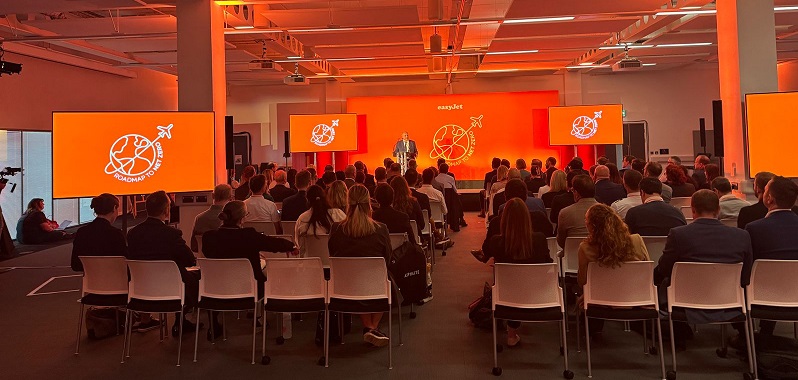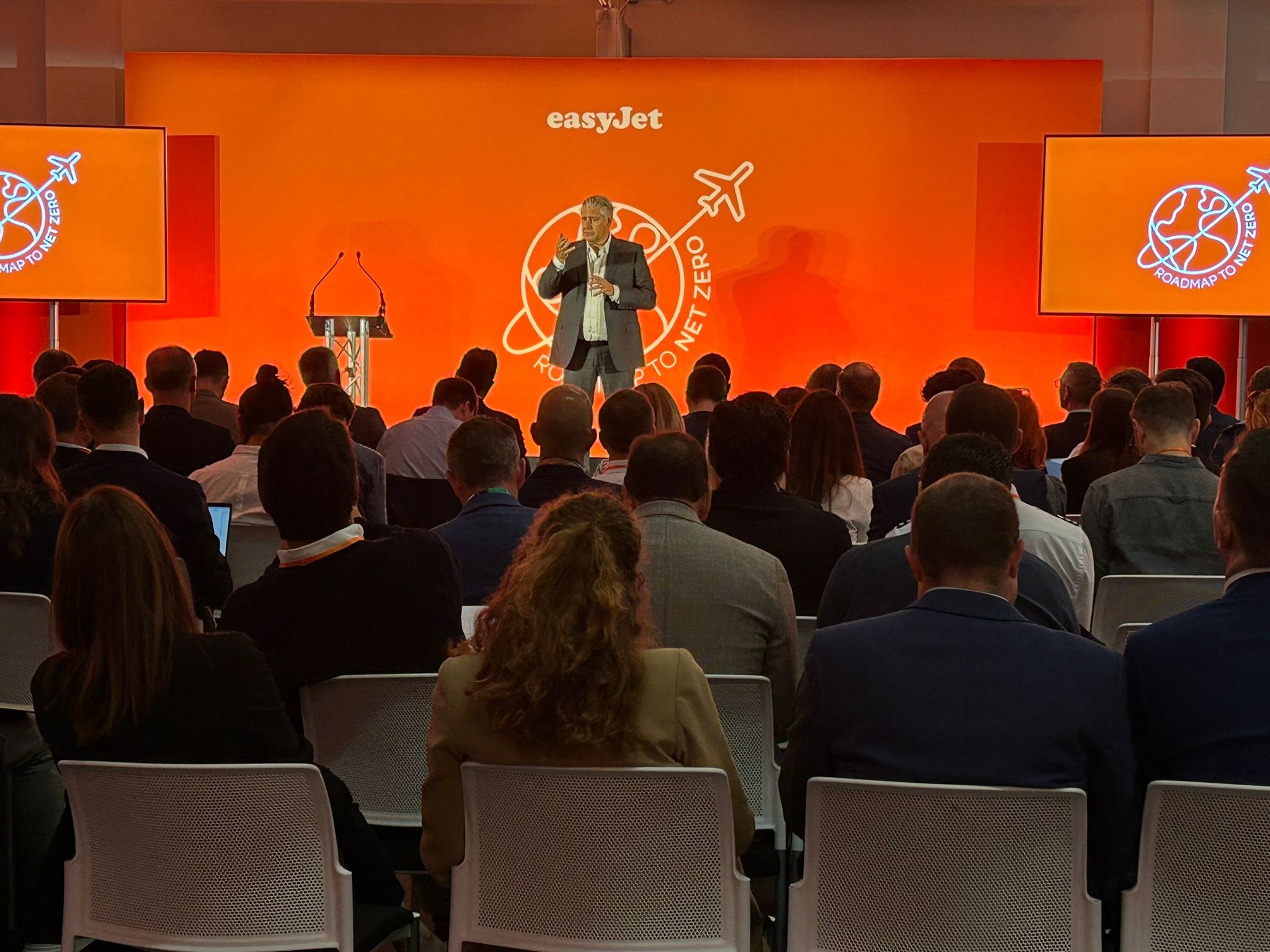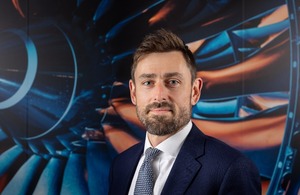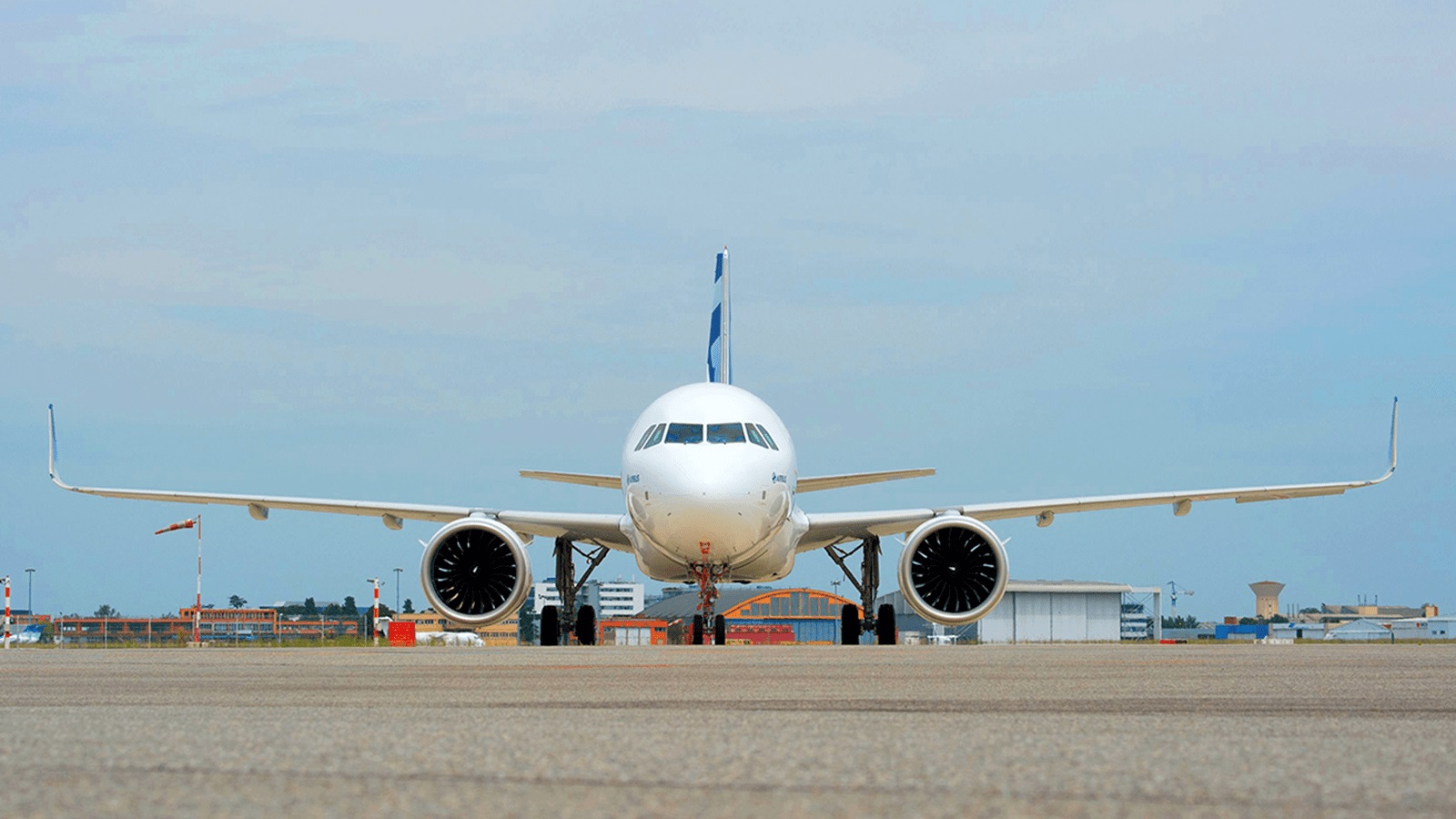Cranfield hosts easyJet net zero event

Above: Mike Kane MP addresses the easyJet Net Zero event at Cranfield University.
Courtesy Cranfield University
The event was opened by the Chief Executive Officer of easyJet, Johan Lundgren, who discussed the impact inefficient airspace across Europe is having on CO2 emissions, referring to a new easyJet study which reveals airspace modernisation could save 18 million tonnes of CO2 a year from European aviation.
Speaking to an audience of aviation industry representatives and UK and European media, Minister Kane said that UK airspace management is “an analogue system in a digital age” and “the highways in the sky were mapped shortly after the College of Aeronautics [the forerunner to Cranfield University] opened in 1946, so it’s safe to say that airspace modernisation is long, long overdue.”
In an industry first, easyJet has calculated the impact inefficient airspace across Europe is having on CO2 emissions, in a bid to finally evidence why reform is so badly needed and long overdue.
Using AI, the airline monitored every single one of its flights over a 12-month period to understand how airspace inefficiency is impacting its operations and therefore the operations of airlines across Europe.
The results revealed that airspace inefficiencies increased CO2 emissions by 10.62% – equivalent to 663,710 tonnes CO2 – all because of the current airspace regime across Europe.
Applying its analysis to the whole of European aviation, easyJet estimates that airspace modernisation could help eliminate 18 million tonnes of CO2 from European skies every year, a figure that reveals the size of this opportunity – and one that could be a significant route to creating an immediate and meaningful carbon emissions reduction across European aviation.
The analysis, conducted by leading experts in easyJet’s Flight Efficiencies team, found that a significant proportion of this inefficiency occurs around terminal airspace, particularly during descent, which is largely due to outdated or poorly designed lower airspace.
While airspace inefficiency is a universal issue across the whole of Europe, the greatest inefficiencies for easyJet’s operations were in the UK – with 7 of the 10 least efficient routes occurring inbound into London Gatwick, with the South East of the UK a particular problem area due to high demand and capacity constraints.
However, with the UK having jurisdiction over its airspace, and the new Government having pledged in its manifesto to support the modernisation of UK airspace , there is hope that these changes are closer to being achieved than ever before and that the UK can become an international leader in driving airspace reform.
The countries with the greatest need for improvement are the United Kingdom, Italy, France, Spain, and Switzerland. For example, 19% excess emissions is typically produced on flights between London Gatwick and Malpensa.
Factors causing greatest inefficiencies
As part of this project, easyJet carried out a comprehensive evaluation of all airways utilised across its network, to pinpoint the areas of greatest inefficiency and where immediate reform is needed. The greatest inefficiencies include:
- Climb – The analysis identifies London Gatwick, Milan Malpensa, Geneva, Naples, and Paris Charles de Gaulle as having the most inefficient departures. To improve efficiency, airspace must be redesigned to support Continuous Climb Operations (CCO), enabling aircraft to reach cruising altitude more efficiently.
- Cruise – the upper airspaces over Italy, United Kingdom, France and Spain have been identified as some of the most problematic regions in Europe. These areas face significant inefficiencies due to outdated procedures, complex routing, and limited airspace flexibility. To improve efficiency in these upper airspaces, it's crucial to expand Cross-Border Free Route Airspace (FRA) Operations to allow for more direct routing and reduce fuel consumption.
- Descent – Inefficiencies are particularly notable in the United Kingdom, Italy, Switzerland and France, where arrival procedures result in extended flight times and increased fuel consumption. Also notably, the recently redesigned arrivals in London the recently redesigned arrivals in London Luton (LTN) and Milan Malpensa (MXP) have proven to be less efficient than the previous procedures, adding an average of 10 minutes to planned flight times. These inefficiencies are often due to overly complex procedures that prioritise controller workload over operational efficiency. To improve descent inefficiencies, it is essential to redesign arrival procedures with a focus on reducing track miles, implementing Continuous Descent Approaches (CDAs) and minimising level-offs.
The UK needs to complete the airspace modernisation programme across the country with a focus on the south east and ensuring that there is a single entity responsible for the timely delivery of the programme. Across Europe, easyJet plans to collaborate with individual countries, Air Navigation Service Providers (ANSPs) and airports to identify ways to solve these inefficiencies. It says it is essential to also deliver the quick wins, for example, implementing Free Route Airspace in the UK and France – the last countries to implement completely across their regions and which would drive immediate efficiency improvements.
To unlock the over 10% efficiency gain in airspace operations, easyJet’s model indicates we need to put in place structural changes that modernise outdated airspace and remove historic constraints. The quickest wins can be achieved by redesigning lower airspace procedures, such as Standard Terminal Arrival Routes (STARs) and Transitions, to better align with modern aircraft capabilities. Implementing Required Navigation Performance with Authorisation Required (RNP-AR) approaches at more airports will also bring significant improvements. These procedures, already successfully deployed in Scandinavia, offer highly predictable tracks that avoid overflying densely populated areas, reducing both noise pollution and environmental impact.
ANSPs should prioritise the implementation of ATS B2 Automatic Dependent Surveillance - Contract (ADS-C) to enable Trajectory-Based Operations (TBO) well before the 2027 mandate, to meet the growing demands for airspace efficiency, safety, and environmental sustainability. The Maastricht Upper Area Control Centre (MUAC) has already successfully implemented this technology since May 2022, demonstrating its effectiveness in optimising air traffic management.
Johan Lundgren (below), CEO of easyJet, said: “Airspace modernisation is the quickest and most cost-effective way to reduce carbon emissions but the process is being shackled by needless bureaucracy.”

Courtesy easyJet
“Our data proves that the airspace corridors we use today, which were built in the 1950s, are simply no longer fit for purpose. Adapting them to be more efficient would not only be significant in terms of CO2 reduction but for journey times and improving the experience of passengers.
“This can can’t be kicked down the road any further. If we’re serious about achieving net-zero, policymakers and regulators need to come together to find a route to unlock these significant gains and now.”
Aviation Minister Mike Kane said: “The aviation industry is set to undergo a green revolution, with airspace reform playing a crucial role.
“EasyJet's modelling shows how a modernised airspace system will help ease delays, support decarbonisation and reduce noise – all supporting this Government’s plan to boost economic growth.”
EasyJet also announced a collaboration with US based start-up JetZero , which is developing a blended-wing aircraft, capable of supporting hydrogen technology.
Cranfield is long-term academic partner of easyJet, working most recently on a groundbreaking airside hydrogen refuelling trial with the airline at Bristol Airport.
The University’s Deputy Vice-Chancellor, Professor Dame Helen Atkinson joined a panel session during the event which also included Alan Newby, Director of Aerospace Technology and Future Programmes at Rolls-Royce, Cedric Laurier, CTO at Gatwick Airport, and Andy Reynolds, Head of ZEROe hydrogen Storage and Distribution Systems at Airbus.
Professor Dame Atkinson outlined the development of Cranfield’s new Hydrogen Integration Incubator (CH2i), a £69 million investment which will create the first large-scale hydrogen research hub at any UK airport. CH2i builds on Cranfield’s close ties to industry and will help unlock the technical challenges around hydrogen-enabled aviation.
Professor Atkinson said, “Cranfield is well known to be one of the most advanced universities both in terms of aviation and aerospace research, and in terms of working closely with industry to develop ideas into products and applications. So it was a real pleasure for us to host so many key partners and the Aviation Minister at this event, and discuss how as an ecosystem of industry, academia and government, we must work together towards decarbonising aviation. We can play a major role in helping industry to develop the necessary skills for hydrogen in civil aviation.”

Courtesy easyJet
Minister Kane also commented on the need for a collaborative approach to achieve net zero. He said: “Cranfield is a hub of expertise in aerospace…and bringing academia and industry together is essential, as we power towards net zero aviation.”












